


|
Let the unknown = X! A crowded
street car! A man is murdered! Everyone saw him die, but no one saw the killer! Many
people (even his own partner) had good reason to hate Longstreet. Inspector Thumm's few
clues all led up a blind alley. He finally sought the aid of Drury Lane, retired
Shakespearean actor, who made a hobby of solving crimes. Seated amid the splendor of the
vast medieval halls of his castle on the Hudson, Drury Lane hears the story from the
Inspector. He knows who the murderer is, but refuses to reveal his identity until he has
sufficient evidence for the police to arrest him. This story is crammed full of chilling
thrills! Why was the streetcar conductor murdered? Why won't Longstreet's partner talk?
The answers to these questions and others all lead to the solution of this puzzling
mystery. |
|
"Unquestionably a superior piece of work
in the mystery field, literate and intelligent, its puzzle slyly hidden, and
its occasional references to things of the theater adding interest and
novelty... he has a remarkable grasp of the technique." --
Earl Derr Biggers. "The best mystery story we have read in many a day... the book carries on its enthralling plot in a pleasant, a vigorous style." -- Providence Journal. "Unreservedly we recommend The Tragedy of X. A mystery that will defy the most astute." -- Philadelphia Inquirer. "One of the pleasantest excuses that can be found for missing sleep these nights is The Tragedy of X." -- John Mason Brown, N.Y. Evening Post "The Viking Press has made no mistake in choosing this book as its first venture into the mystery field." -- Isaac Anderson, New York Times. "Drury Lane, detective in his spare time because nothing is more dramatic than real life, is called in. With much pesturing and gesturing, he solves the mystery in a manner that baffles sleuths and book reviewers." -- Gremin Zorn, Long Island Sunday Press |
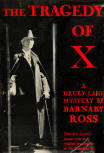 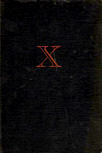   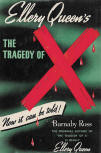 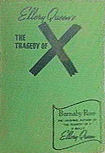   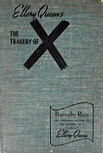 |
|
Top row left to
right: Both dust cover and hard cover for Viking Press, dust and
hard cover for Grosset &
Dunlap. Bottom row left to right: two more hard cover variations for for Grosset & Dunlap, dust cover and hard cover for Stokes. (Click on the covers to see the differences) * |
| The Saturday Review, "Thrillers" by William C.
Weber - June 18, 1932 "Preposterous is also the word to describe Drury Lane, the trick criminal investigator who gyrates through the pages of an otherwise excellent mystery story, "The Mystery (sic) of X" by Barnaby Ross. It, too, runs to long words and subtle deductions but is chockfull of action and has a surprising denouement which nobody under the sun will ever believe." The Daily Star, Long Island City, Queens Borough, N.Y. , "All about Books" by Victor Ullman, March 31. 1932 "Having read but one or two detective stories I cannot judge whether "The Tragedy of X, a Drury Lane Mystery," by Barnaby Ross, is the remarkable thing the people at Viking Press say it is, Mr. Charles Reed Jones will deal with the book in "It's a Crime" and we can depend on his judgment. But Viking says that the editors waited seven years for this story, and I can well believe it after seeing the list of rules laid down for judging a mystery. "The Tragedy of X" becomes doubly important, really an event, for, in fact, with those rules they might have waited many a lifetime before publishing a mystery. Here are a few of them: I. No Malay krisses, sliding panels, (Fu (if any) Manchus, walking corpses or other devices of the un-sound-and-fury school of writers. II. No new characters dragged in by the hair just before the fall of the curtain simply in order to pin the crime on him or her. III. No screamingly funny characters — even if they were funny we wouldn't like them in a detective story. I, in my ignorance, wonder just what the Viking editors have left for a mystery writer to write about." |
 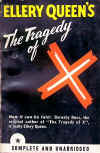 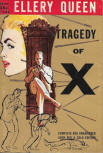 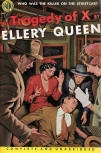  |
|
The Tragedy of X by Ellery Queen
(under the pseudonym Barnaby Ross) is a quintessential 1930s mystery
novel that introduces readers to
Drury Lane, an eccentric
retired Shakespearean actor-turned-sleuth. Set in the bustling heart of
New York City, the novel follows the mysterious murder of Harley
Longstreet, a prominent and well-disliked broker, who dies unexpectedly
aboard a crowded streetcar. Though everyone on board saw Longstreet
fall, no one witnessed the killer, marking the start of a baffling
murder investigation. The crime is unusual: Longstreet reaches into his pocket for his glasses, only to pull out a bloody hand before collapsing dead on the floor. This grisly scene, punctuated by the revelation of a nicotine-tipped-needle hidden within a cork ball, is Queen’s first experiment with what would later become known as the “dying message.” The novel follows two additional murders on public transportation, as both the killer’s methods and motives unfold with chilling precision. Inspector Thumm and District Attorney Bruno find themselves without leads and turn to Drury Lane, who lives on an estate known as The Hamlet—a grand castle on the Hudson River filled with medieval halls and Shakespearean grandeur. Lane, who is both a celebrated matinee idol and a master of disguise, has an affinity for mysteries, viewing them as a "refinement of human drama.” Seated in his ornate home, Lane listens to the details of the case and almost immediately deduces the identity of the murderer. However, he refrains from disclosing the culprit’s name until he can substantiate his theory with solid evidence, opting to tease out the truth through further investigation. As the novel’s "amateur sleuth," Lane’s exaggerated theatricality makes him a unique figure in crime fiction. Described as "greater than life," he embodies dramatic flair and sophisticated reasoning, coupled with his signature skill in adopting various disguises—a talent reminiscent of Arsène Lupin and Sherlock Holmes. These disguises allow him to infiltrate circles unknown, though critics like Charles Reed Jones expressed frustration at the unrealistic nature of his transformations, which deceive even those closest to the killer. Ellery Queen’s storytelling approach grants readers access to every clue as they are presented to Lane, challenging them to solve the mystery themselves. In this, The Tragedy of X adheres to a rigorous standard that eschews melodrama, caricature, and last-minute revelations typical of the “unsound and fury” school of mystery writing. Viking Press, which waited years for a mystery novel that met these standards, chose this book as their first foray into the genre, recognizing it as a refreshing departure from conventional crime stories. |
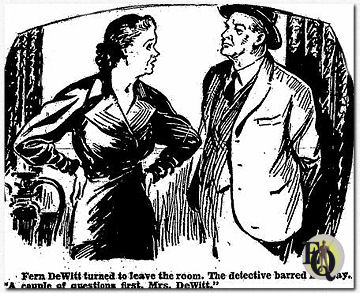 |
| Above: Artwork for The Tragedy of "X" by Ellery Queen (Chapter 10) as published on December 11, 1941 in The Newark Courier-Gazette and Marion Enterprise. It reads: "Fern DeWitt turned to leave the room. The detective barred her way. "A couple of questions first, Mrs. DeWitt." |
|
The novel received considerable praise upon release.
The Providence Journal commended its “enthralling plot,” while
the Philadelphia Inquirer admired the challenge it posed even to
seasoned mystery readers. Yet, not all reviewers were completely taken;
the Saturday Review labeled Lane’s investigative style “preposterous”
but ultimately lauded the novel’s action and “surprising denouement.” The Tragedy of X resonates not only for its imaginative setting in New York City during the early 1930s but also for its clever integration of art and deduction. The influence of design and era-specific elements, such as Drury Lane’s estate and Queen’s subtle Art Deco nods (later seen more prominently in The French Powder Mystery*), enrich the novel’s atmosphere. However, some critiques observed that while the mystery was engaging, its solution felt far-fetched, relying on the elaborate yet occasionally implausible disguises and deductions typical of Queen’s early style. The plot deals with three murders committed on transport (e.g. trams, ferries and trains), with the murders themselves being peculiarly nasty (the first murder shows some of EQ's gift for surrealistic mise-en-scène as it is committed by means of a nicotine-tipped-needle-filled cork ball put into the victim's pocket), including Ellery Queen's first "dying message" (the second would appear in The Siamese Twin Mystery) - and the ingenious. The finale is deductive, as in all of the early EQ books, but the solution is somewhat far fetched, and the mystery plot is not especially imaginative. It shows similarities to  both Conan Doyle's
A Study in Scarlet and one of the stories from G. K. Chesterton's The Innocence
of Father Brown. both Conan Doyle's
A Study in Scarlet and one of the stories from G. K. Chesterton's The Innocence
of Father Brown.In The Tragedy of X, Drury Lane makes his memorable debut, marking the start of a series that would bring the character back in The Tragedy of Y and The Tragedy of Z. Readers are left to contemplate each twist and turn, challenged to unmask the killer in a tale that blends suspense, drama, and deduction with an unforgettable protagonist at its core. *Michael E. Grost |
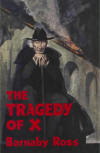  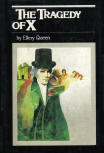 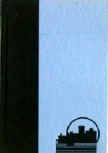  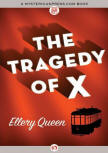 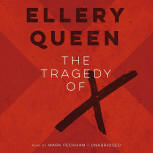 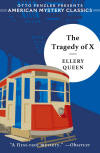 |
| The Daily Star, Long Island City, Queens Borough, N.Y. , "It's A
Crime" by Charles Reed Jones, (Flushing Author of
Mystery Novels), March 31. 1932 "Drury Lane, who makes his debut as a detective in "The Tragedy of X," was a greater Hamlet than Edwin Booth before his retirement in 1928 because of deafness. He lives today at his vast estate, The Hamlet, overlooking the Hudson River at Westchester County. He has quit the stage, except for his annual performance of "Hamlet" at his own private theater on April 23, which the author reminds us is "the commonly accepted anniversary of Shakespeare's birth and death." But, although he has retired from the professional theater, Drury Lane continues to perform before a limited audience of his 'own choosing; his servants who are named for several Shakespearean characters, and New York's District Attorney, whom he will entertain in "The Tragedy of Y" and "The Tragedy of Z," which will be published subsequently. Harley Longstreet, a middle-aged broker, had announced his engagement to Cherry Browne, musical comedy star. Accompanied by a group of friends, they boarded a West Forty-second streetcar. Settled in the crowded car, Long street reached into his pocket for his spectacles. He withdrew his hand suddenly, covered with blood, and fell to the floor, dead. Every member of the party seemed to have had a motive for the murder, although the ingenuity of the murder device seemed to place a definite limit on the search. The story moves rapidly and reasonably through two subsequent murders, quite as harrowing and confusing as the first; but it falls down miserably in the most absurdly artificial solution I have run across in many, many years of detective-story reading. There is one thing you may definitely depend upon: You will never guess the answer.  I
might have smiled a little rather early in the book when Drury Lane, a la
Sherlock Holmes, decided to try his well-practiced hand at disguises; but I
was ready to swear when I learned that, the murderer had been running in and
out of the picture with a series of such perfect disguises that neither the
great Drury Lane nor the murderer's closest buddies were able to penetrate
them." I
might have smiled a little rather early in the book when Drury Lane, a la
Sherlock Holmes, decided to try his well-practiced hand at disguises; but I
was ready to swear when I learned that, the murderer had been running in and
out of the picture with a series of such perfect disguises that neither the
great Drury Lane nor the murderer's closest buddies were able to penetrate
them." |
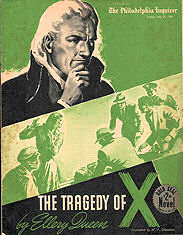 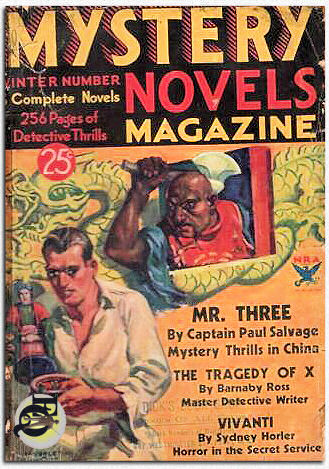 Above left: Cover for section included in The Philadelphia Inquirer May 24. 1941. Illustrated throughout by W. V. Chambers. Above right: In the winter of 1933-1934 Mystery magazine published a winter number. As it contained three full novels it was named Mystery Novels Magazine. One of those three was 'Master Detective Writer" Barnaby Ross' The Tragedy of X. |
|
|
|
The Tragedy of X Translations: |
|
Other articles on this book (1) The Green Capsule – The Tragedy of X Noah Stewart (Oct 2017) (2) Reading Ellery Queen - The Tragedy of X Jon Mathewson (Jun 2013) (3) Deus Ex Machina Ho-Ling (Feb 2016) (4) The Tragedy of Zzzzzzz Brad Friedman (Oct 23. 2018) (5) #917: Mining Mount TBR at The Invisible Event (May 31. 2022) (6) The Tragedy of X Stephen M. Pierce (Jul 7. 2025) - spoilers! |
|
*
Interested readers should know
that the icons/covers
of books, used throughout the
website have extra
descriptions/information not
included in the text on the same
page. Pointing your cursor at
the icon/cover used to reveal
this extra information. To achieve the same effect Firefox users can install an add-on called 'Popup ALT Attribute'. When installed pointing your cursor at an icon/cover results in showing you the details or additional information. |
|
Copyright © MCMXCIX-MMXXIV Ellery Queen, a website on deduction. All rights reserved. |